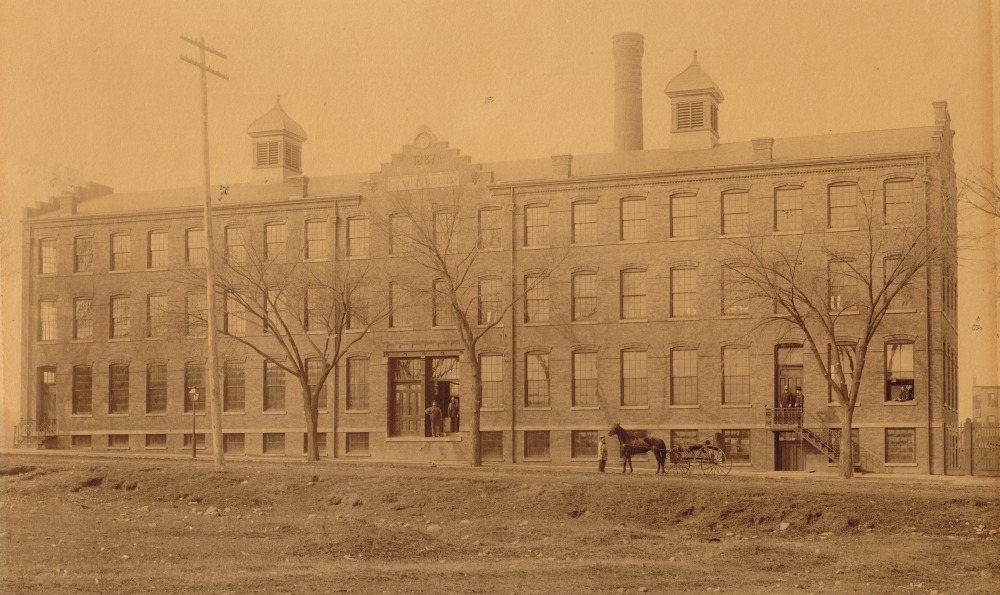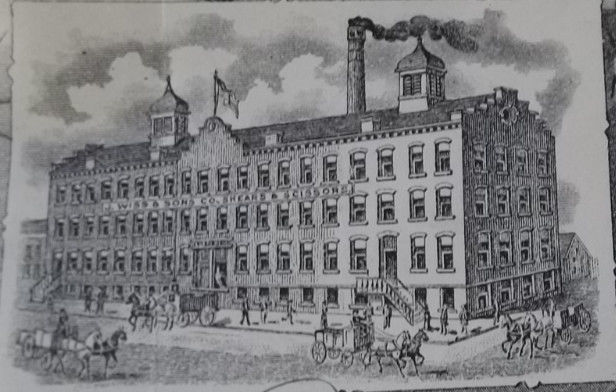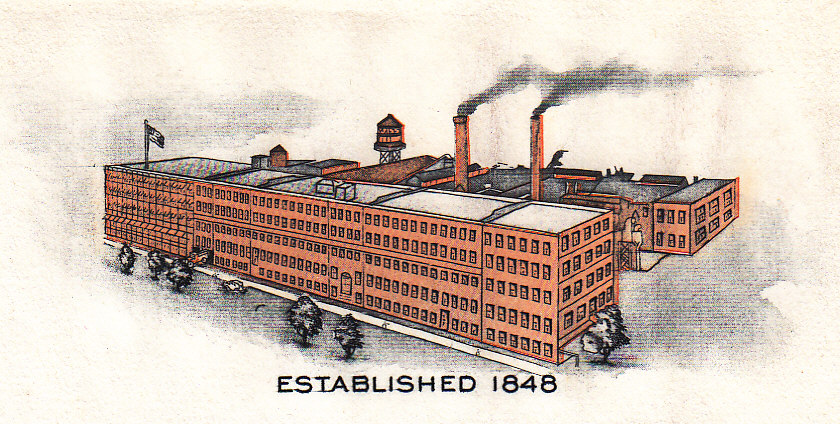
Another factor for this location was the factory was at the intersection of West Market St (formerly Warren St) and Central Ave, which had horse-drawn streetcar lines. And another factor was this was in the section known as the West Ward. It was one of the German sections of Newark, and the factory's employees were primarily German.
The new plant started operation in 1887 with 150 men. Starting from 50 men in 1881, the business built up to a force of 150 men working in various places around Newark. This consolidated them and allowed for further expansion.
Various street numbers were used over the years as their address. They used different numbers in different publications in order to track inquires. The office building was built in the mid-1910s (see it appear in 1917 below), and that gave them a door at No. 33. Departments were then used to track inquires.
In 1914, Wiss acquired the manufacturing facilities of R. Heinisch and became the largest producer of fine scissors and shears in the world. Wiss moved Heinisch to South 6th Street. In the early 1950s, they used 42 S. 6th St as a claudestine address. The back building was also referred to as the Heinisch building. In the 1950s, the north end was used for rentals and the south end for manufacturing. Later it became all manufacturing.
A circa 1890 picture of the factory as originally built. The print is 14" × 10-1/2". Frederick C.J. Wiss is standing in front of the right door facing forward. His younger brother Louis is to his left. This photo is from the Newark Public Library's Charles F. Cummings New Jersey Information Center. High resolution scans exist. Get permission from the library to obtain. The New Jersey Historical Society also has this picture, plus they have one of the backside of the factory.

A picture from a 1901 billhead. Unfortunately I was underbidder and I do not have a decent scan of this. The artist here removed the trees, and added smoke to the smokestack. You will see that adding smoke was considered for a long time a positive thing to show.

A circa 1906 postcard of the factory. The factory has already been expanded on both sides. Note the building starts with three stories at the near end and is four at the far end. A version of this also exists with a two line caption, the second line being "Main Building where WISS "Stielweld" Shears are made." Those postcards were sent out to their customers. This postcard (with single line caption) was reproduced on page 14 of Newark, The Golden Age, by Jean-Rae Turner, Richard T. Koles and Charles F. Cummings, 2003. [The book's caption is riddled with errors. This factory did not begin in the 1840s, but was opened in 1887. J Wiss never made jewelry or silverware. The jewelry store branch of the company simply retailed these items. The Short Hills Mall branch was opened 1961, when the mall opened. It was not moved.] The book in WorldCat. The book is available at Amazon, and page 14 is in the preview. The postcard pictured here is from the Newark Public Library's Charles F. Cummings New Jersey Information Center. It has an undivided back and is unused.
1911 Aerial View. This from the 1912 Catalog, but dated 1911, as the identical picture is dated as such in the 1911 catalog. The building length along Littleton Avenue is the same. The same image, without the air brushing to make it look cloud-like, exists as a postcard. This image was used as letterhead for many years after this. Nothing was cropped out. The only change for the letterhead was the sky above the smoke was removed. Click on web-sized image to see detail.
Aerial View from the circa 1917 Catalog. The building with the flag has been added at the left. The rest of the picture is the same as the prior one, but with more intense smoke.
Aerial View from the 1919 Catalog. The building at the left with the flag now has awnings. The water tower and another water tank are new. There are more buildings in the surrounding neighborhood. With more factories in the background spewing smoke.
Before 1925 Aerial View. Another story has been added to the main buildings. The roof line is changed and the cupolas are gone. The signage on the front was changed and razors has been dropped. The manufacture of straight razors was discontinued in the latter part of 1923.
This image from the 1934 Catalog. The identical picture was also in the 1925 catalog. The main buildings from the image were used as letterhead in the late 1920s. See next.
In this letterhead version of the prior picture the extraneous buildings were cropped out and some shadows were changed..
Dated January 1930 on the back. This is the same as the above, but being a scan of a photo is higher quality. Different extraneous surroundings were removed. And the vehicles were hand painted over, and smokestacks were painted over in the back. This is obvious if you click the web-size image and look at the 300 d.p.i. scan. From the Newark Public Library's Charles F. Cummings New Jersey Information Center. Permission needed from them to reproduce.
This street photo was published twice. In the Newark Evening News on January 25, 1930, and in the Newark Sunday News on March 16, 1952 on page 6. From the Newark Public Library's Charles F. Cummings New Jersey Information Center.
From the letterhead in the late 1940s. A redrawing of the picture a couple above. 1920s cars omitted.

From A Story of Shears and Scissors 1948. This is the first redo since before 1925.
This was on the cover of the 100th Anniversary Celebration Program from the celebration dinner on September 18, 1948. The shadows were changed.
This picture has all the 1960s additions, including the office building in the upper right that was completed in 1969. This pictures how the factory looked when the company was sold in 1976. From the Newark Public Library's Charles F. Cummings New Jersey Information Center. Permission needed from them to reproduce.